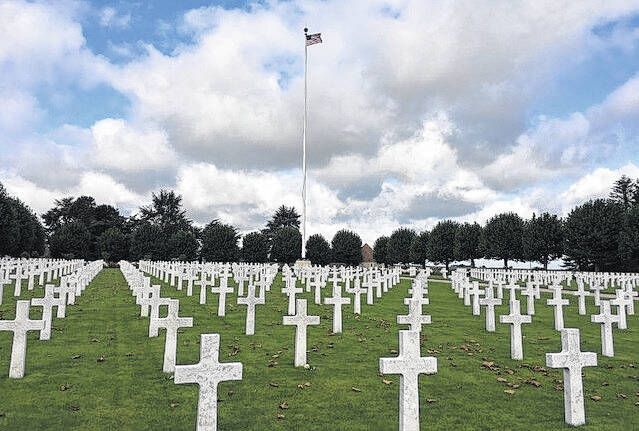
This is cemetery of the World War I war dead of the American 30th and 27th Divisions in the Somme Region of France.
Photo courtesy of Piedmont Physic Garden
Click here to subscribe today or Login.
Take up our quarrel with the foe:
To you from failing hands we throw
The torch; be yours to hold it high.
If ye break faith with us who die
We shall not sleep, though poppies grow
In Flanders fields.
Red poppies dot lapels — or poke out of shirt button holes or pockets or sit on wire stems twisted around purse straps or lie silently atop a computer — not because they brighten a day nor because they rank high on the list of beautiful, eye-catching blooms.
Poppies came to symbolize the vital importance that each generation remember those in the military who died serving this country thanks to that poem written by Lt. Col. John McCrae to honor 87,000 allied soldiers killed at Flanders Fields in Belgium during the First World War.
For four years the site stood repeatedly as a major zone of contention. From visitflanders.com:
A million soldiers from more than 50 different countries were wounded, missing or killed in action here. Entire cities and villages were destroyed, their population scattered across Europe and beyond. The destruction of the city of Ypres and the brutal conditions endured during the Battle of Passchendaele (Third Battle of Ypres) became worldwide symbols for the senselessness of war. Today, the peaceful region still bears witness to this history through its monuments, museums, cemeteries and the countless individual stories that link it with the world.
Most Memorial Days, the relentless carnage of that war seems a dusty memory, a century-old saga bearing scant relevance in our hi-speed Internet-of-things world with big data and all-on-demand. Surely such a global conflagration cannot happen again, we comfort ourselves, there is too much at stake for everyone.
But widespread war remains very much a beast barely caged, and this year we celebrate Memorial Day with immediacy of vigilance thrown in our faces thanks to the Russian war of choice unleashed in Ukraine.
No, our troops are not fighting, at least not formally (there are Americans serving among an estimated 20,000 people who have formed an “International Legion” in Ukraine’s defense). But we play a semantic shell game if we dismiss this horror as “not in our interest.”
Vladimir Putin has proven we are always one madman away from fighting for everything we hold dear. Ukraine quickly became a visual reminder of the risks in letting down our guard, an endless source of images showing the stunning destruction and brutality a thuggish army of a lawless nation can inflict in months, even days. The Russian nuclear saber rattles at every setback their surprisingly incompetent forces suffer. Nations that stayed scrupulously neutral for seven decades clamor for the protection of the NATO alliance in the wake of one man’s fevered delusions of past glory becoming hellish nightmare.
And the NATO alliance is our alliance. Its soldiers are our soldiers. The aid and weapons member nations send, we send.
And our soldiers stand ready, grabbing the torch tossed from failing hands to hold high.
Memorial Day must always be more than the gathering, grilling, and the reverie of a long weekend. Take time to remember those who died protecting this country. You likely know someone who served or serves now. You can certainly see in Ukraine, with immediacy, what they protected us against. What they protect still.
Don’t break faith with them.
— Times Leader




